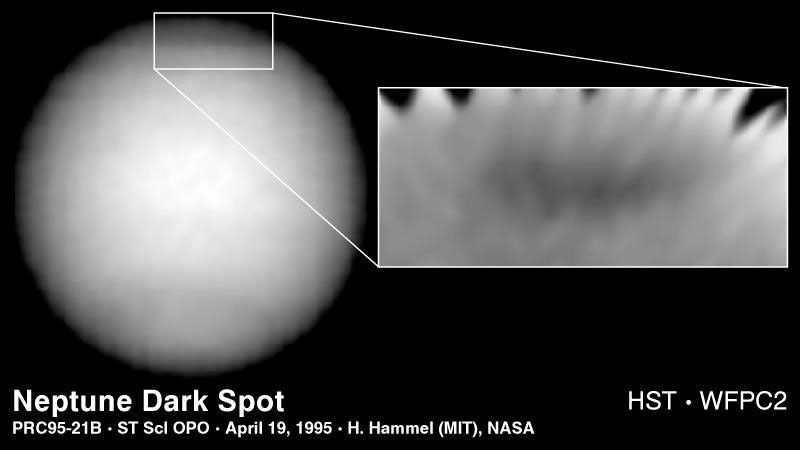1 min read
Hubble Finds New Dark Spot on Neptune

NASA's Hubble Space Telescope has discovered a new great dark spot, located in the northern hemisphere of the planet Neptune. Because the planet's northern hemisphere is now tilted away from Earth, the new feature appears near the limb of the planet.
The spot is a near mirror-image to a similar southern hemisphere dark spot that was discovered in 1989 by the Voyager 2 probe. In 1994, Hubble showed that the southern dark spot had disappeared.
Like its predecessor, the new spot has high altitude clouds along its edge, caused by gasses that have been pushed to higher altitudes where they cool to form methane ice crystal clouds. The dark spot may be a zone of clear gas that is a window to a cloud deck lower in the atmosphere.
Planetary scientists don't know how long lived this new feature might be. Hubble's high resolution will allow astronomers to follow the spot's evolution and other unexpected changes in Neptune's dynamic atmosphere.
The image was taken on November 2, 1994 with Hubble's Wide Field Planetary Camera 2, when Neptune was 2.8 billion miles (4.5 billion kilometers) from Earth. Hubble can resolve features as small as 625 miles (1,000 kilometers) across in Neptune's cloud tops.
- Object NameObject NameA name or catalog number that astronomers use to identify an astronomical object.Neptune
- Release DateApril 19, 1995
- Science ReleaseHubble Discovers New Dark Spot on Neptune
- CreditH. Hammel (Massachusetts Institute of Technology) and NASA
Related Images & Videos

Three Snapshots of Neptune
These NASA Hubble Space Telescope views of the blue-green planet Neptune provide three snapshots of changing weather conditions. The images were taken in 1994 on October 10 (upper left), October 18 (upper right), and November 2 (lower center), when Neptune was 2.8 billion miles...
Share
Details
Claire Andreoli
NASA’s Goddard Space Flight Center
Greenbelt, Maryland
claire.andreoli@nasa.gov




























